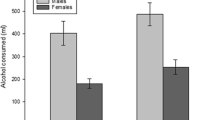Abstract
Forty-eight male normal drinkers were given a beverage to drink containing either tonic plus alcohol or tonic alone, and then were asked to perform arithmetic problems under either stressful or nonstressful conditions. Self-report measures of positive and negative affect and actual measures of physiological arousal (pulse rate and finger pulse volume) were collected at four times: baseline, ascending limb of the blood concentration BAC curve. Results indicated that (a) the stress manipulation was effective in increasing negative and actual physiological arousal, (b) subjects were more accurate in estimating the amount of alcohol they consumed under stressful than under nonstressful conditions, (c) alcohol was not effective in reducing the negative affect or physiological arousal produced by the stress, and (d) alcohol was effective in reducing negative affect and increasing positive affect under nonstressful conditions. These results support the growing body of research that suggests that alcohol produces a complex pattern of responses, one of which may be the enhancement of mood under nonstressful conditions.
Similar content being viewed by others
References
Bloom, L. J., Houston, B. K., & Burish, T. G. An evaluation of finger pulse volume as a volume as a psychophysiological measure of anxiety.Psychophysiology 1976,13 40–42.
Burish, T. G. EMG biofeedback in the treatment of stress-related disorders. In C. K. Prokop & L. A. Bradley (Eds.),Medical psychology: A new perspective. New York: Academic Press, 1981.
Burish, T. G., & Houston, B. K. Causal projection, similarity projection, and coping with threat to self-esteem.Journal of Personality 1979,47 57–70.
Cahalan, D., Cisin, I., & Crossley, H.M.American drinking practices. New Brunswick, New Jersey: Rutgers Center of Alcohol Studies, 1969.
Cronbach, L., & Furby, L. How should we measure “change” — or should we?Psychological Bulletin 1970,74 68–80.
Freed, E. X. Alcohol and mood: An updated review.International Journal of the Addictions 1978,13 173–200.
Higgins, R. L. Experimental investigation of tension reduction models of alcoholism. In G. Goldstein & G. Neuringer (Eds.),Empirical studies of alcoholism. Cambridge, Massachusetts: Ballinger, 1976.
Houston, B. K., & Holmes, D. S. Role playing yersus deception: The ability of subjects to simulate self-report and physiological responses.Journal of Social Psychology 1975,96 91–98.
Levenson, R. W., Sher, K. J., Grossman, L. M., Newman, J., & Newlin, D. B. Alcohol and stress response dampening: Pharmacological effects, expectancy, and tension reduction.Journal of Abnormal Psychology 1980,18 37–43.
Maisto, S. A., Burish, T. G., & Crow, N. Self-reported and physiological measures of alcohol-related internal sensations. In preparation, 1982.
Maisto, S. A., Connors, G. J., Tucker, J. A., McCollam, J. B., & Adesso V. J. Validation of the sensation scale, a measure of subjective physiological responses to alcohol.Behaviour Research and Therapy 1980,18 37–43.
Marlatt, G. A. Alcohol, stress, and cognitive control. In I. G. Sarason & C. D. Spielberger (Eds.),Stress and anxiety (Vol. 3). Washington, D.C.: Hemisphere, 1976.
McCollam, J. B., Burish, T. G., Maisto, S. A., & Sobell, M. B. Alcohol's effects on physiological arousal and self-reported affect and sensations.Journal of Abnormal Psychology 1980,89 224–233.
Naliboff, B. D., Rickles, W. H., Cohen, M. J., & Naimark, R. S. Interactions of marijuana and induced stress: Forearm blood flow, heart rate, and skin conductance,Psychophysiology 1976,13 517–522.
Nowlis, V. Research with the Mood Adjective Check List. In S. S. Tomkins & C. E. Izard (Eds.),Affect, cognition and personality: Empirical studies. New York: Springer, 1965.
Pokorny, M. D., Miller, B. A., & Kaplan, H. B. The brief MAST: A shortened form of the Michigan Alcoholism Screening Test.American Journal of Psychiatry 1972,129 3.
Zucherman, M., Lubin, A., Vogel, L., & Valerius, E. Measurement of experimentally induced affects.Journal of Consulting Psychology 1964,28 418–425.
Author information
Authors and Affiliations
Additional information
This research was suported in part by Grant No. AA00100 from the National Institute on Alcohol Abuse and Alcoholism, and a grant from the Vanderbilt University Research Council.
Rights and permissions
About this article
Cite this article
Burish, T.G., Maisto, S.A. & Shirley, M.C. Effect of alcohol and stress on emotion and physiological arousal. Motiv Emot 6, 149–159 (1982). https://doi.org/10.1007/BF00992461
Issue Date:
DOI: https://doi.org/10.1007/BF00992461




